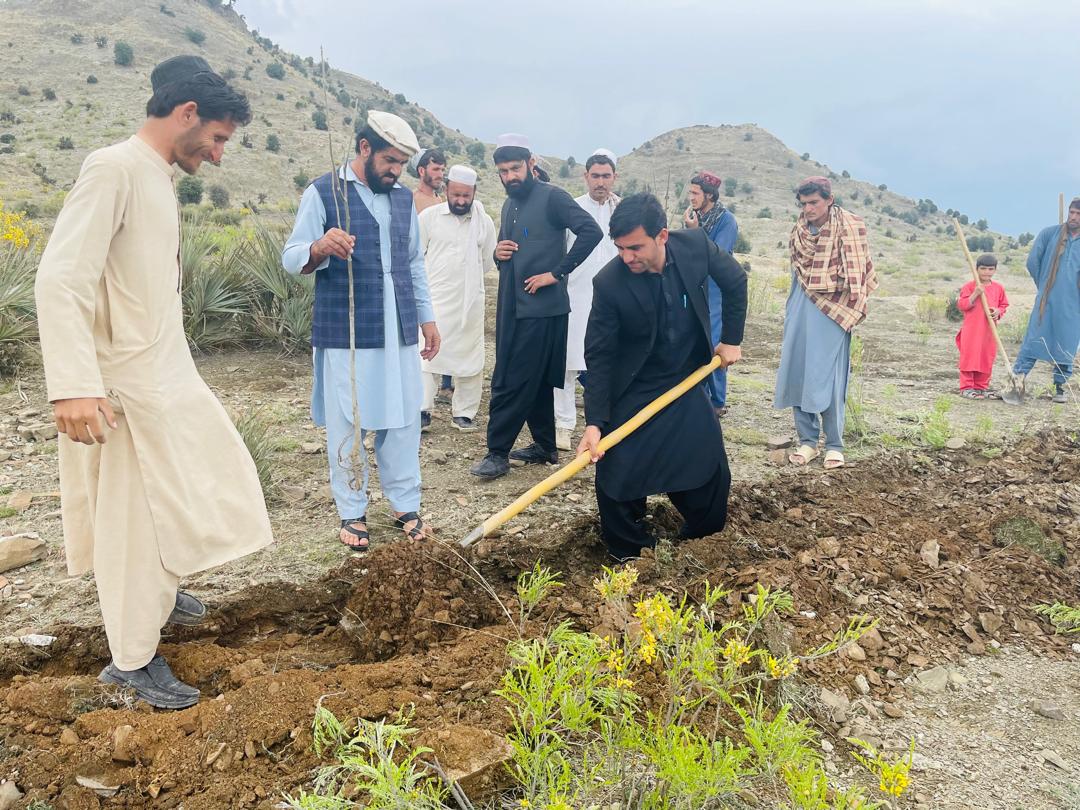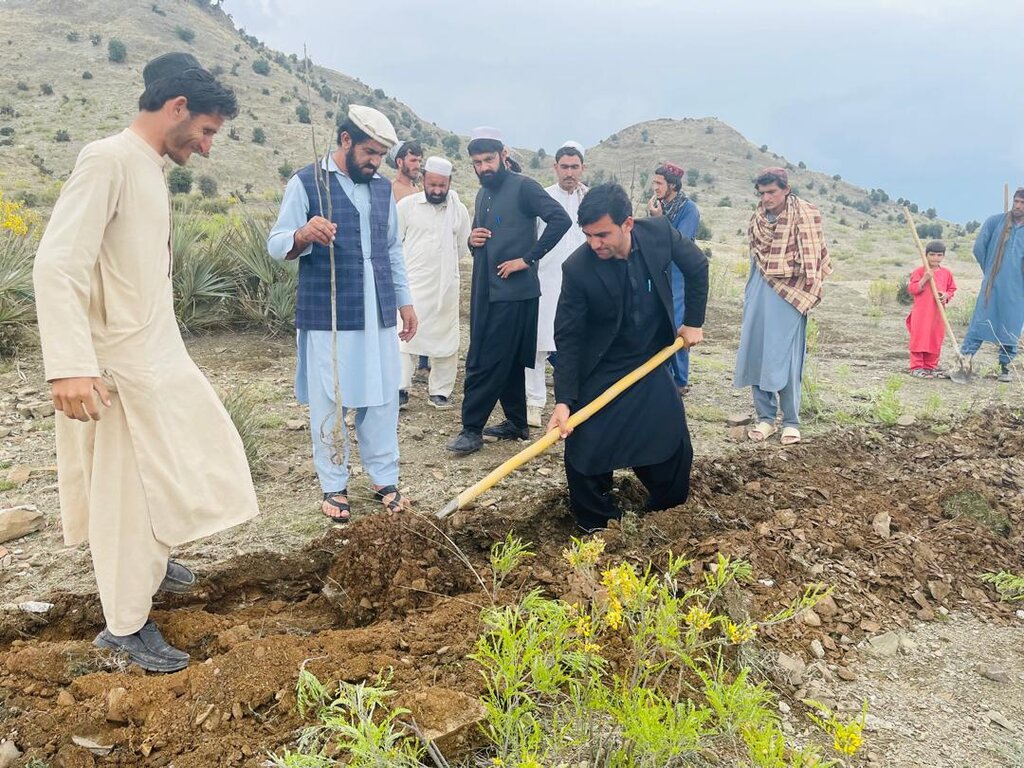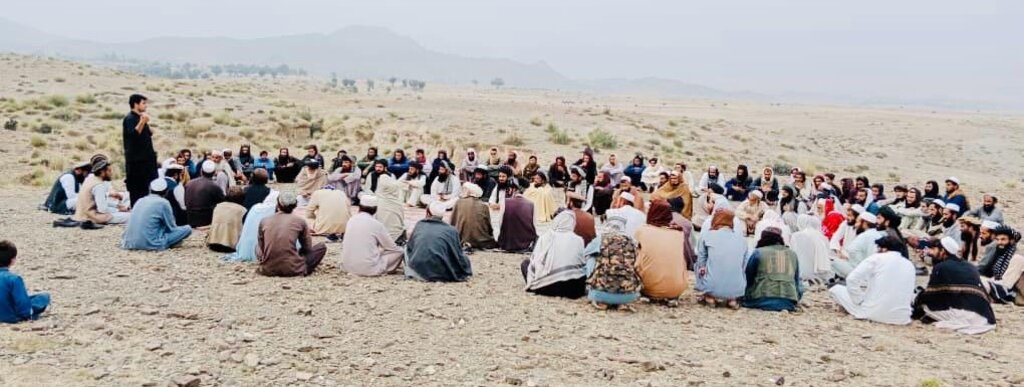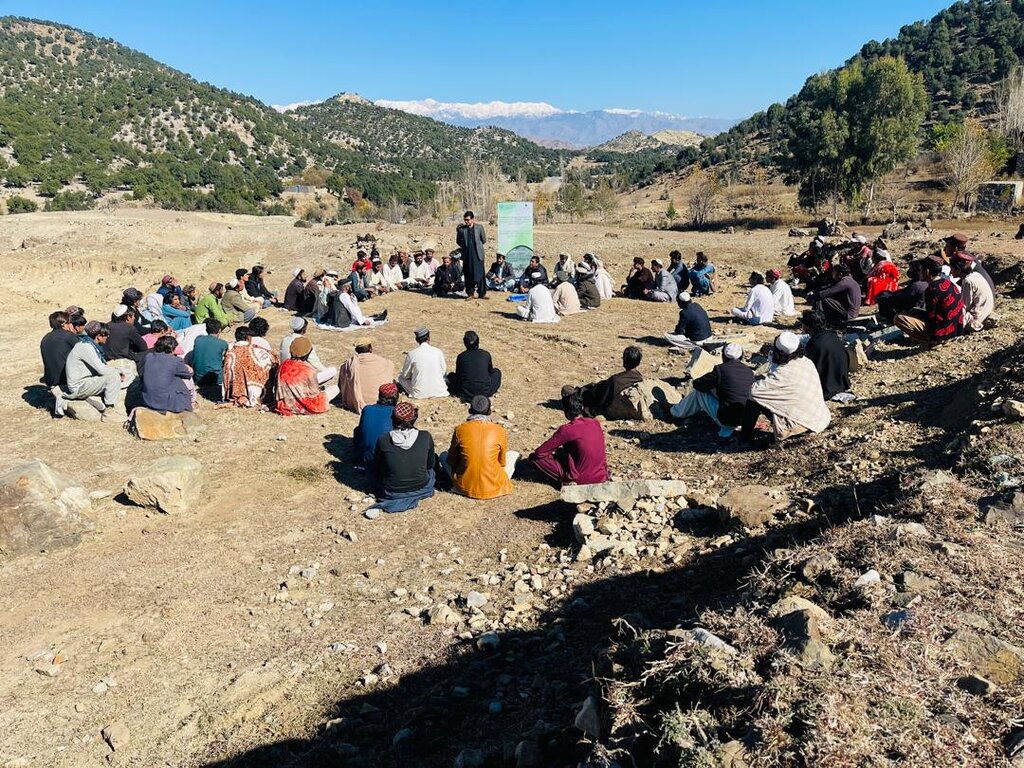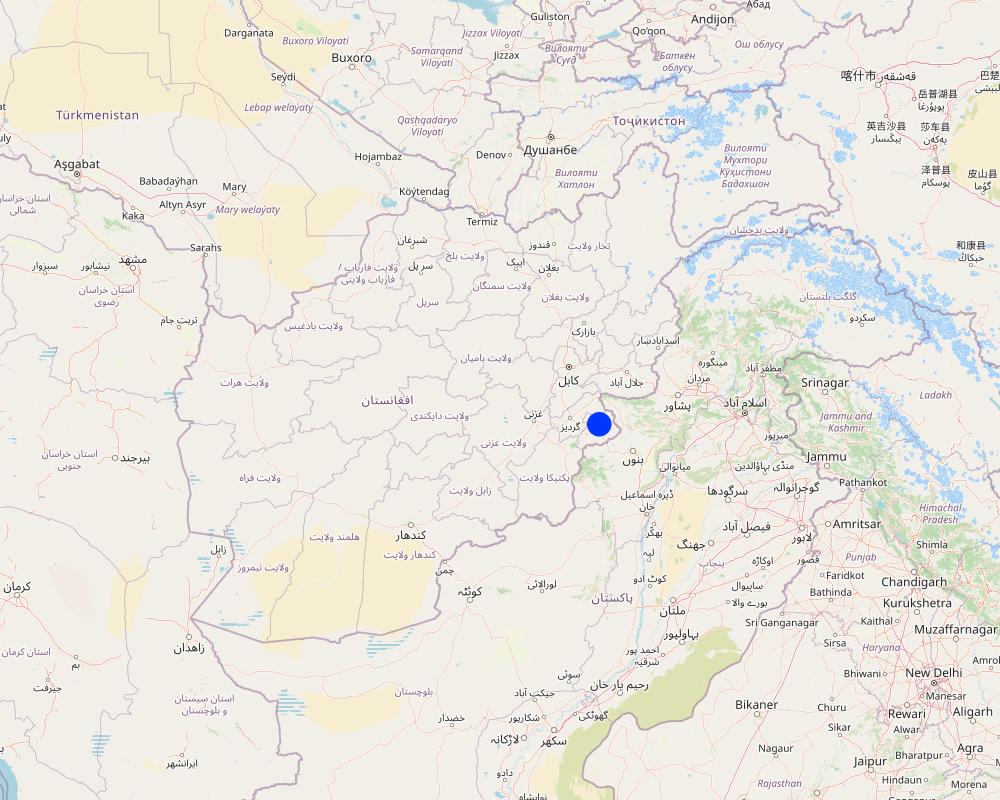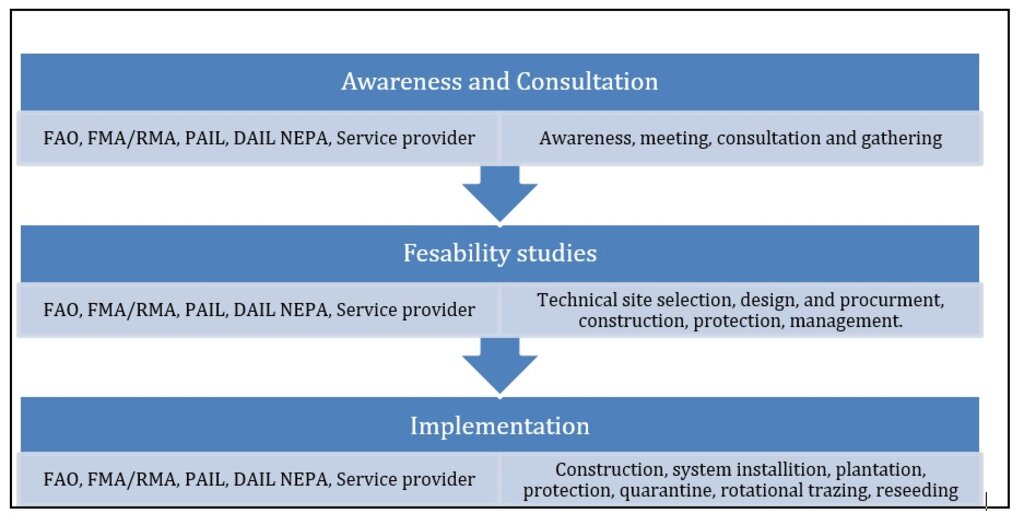Community based reforestation initiatives to restore degraded forest and rangeland [Afghanistan]
- Creation:
- Update:
- Compiler: Mohammad Aslam Hasand
- Editors: Megha bajaj, Afghanistan Safi, Mohammad Arif
- Reviewers: Rima Mekdaschi Studer, Illias Animon, Muhammad Ishaq Safi
د ټولنې پر مټ د بيا رغنيز نوښت له لارې د تخريب شوي ځنګل او څړځای رغول
approaches_7470 - Afghanistan
- Full summary as PDF
- Full summary as PDF for print
- Full summary in the browser
- Full summary (unformatted)
- Community based reforestation initiative to restore degraded forest and rangeland.: March 6, 2025 (inactive)
- Community based reforestation initiative to restore degraded forest and rangeland.: March 24, 2025 (inactive)
- Community based reforestation initiative to restore degraded forest and rangeland.: May 2, 2025 (inactive)
- Community based reforestation initiatives to restore degraded forest and rangeland: May 7, 2025 (public)
View sections
Expand all Collapse all1. General information
1.2 Contact details of resource persons and institutions involved in the assessment and documentation of the Approach
SLM specialist:
land user:
Haleem Bakhtawer Khan
0765983451
bakhtawerkhan.halim@gmail.com
Sapari Forest and Rangeland Management Association
Sapari, Sabari, Khost, Afghanistan
Afghanistan
Name of project which facilitated the documentation/ evaluation of the Approach (if relevant)
Community-based sustainable land and forest management in AfghanistanName of the institution(s) which facilitated the documentation/ evaluation of the Approach (if relevant)
FAO Afghanistan (FAO Afghanistan) - Afghanistan1.3 Conditions regarding the use of data documented through WOCAT
When were the data compiled (in the field)?
15/12/2024
The compiler and key resource person(s) accept the conditions regarding the use of data documented through WOCAT:
Yes
2. Description of the SLM Approach
2.1 Short description of the Approach
Community-driven reforestation initiative that involves awareness-raising, capacity building, feasibility analysis, and collaboration among various stakeholders to address land degradation and promote sustainable forest and rangeland management
2.2 Detailed description of the Approach
Detailed description of the Approach:
The main aim of this approach is to contribute to ecosystem restoration, biodiversity conservation and carbon sequestration through community awareness-raising, consultation and capacity building, feasibility analysis, site selection as well as resources mobilization for reforestation initiatives in Khost, Afghanistan.
This community driven initiative emerged, bringing together land users, forest and rangeland management associations, environmental experts, specialists and policymakers from various departments like Provincial Agriculture, Irrigation and Livestock, National Environment Projection Agency, District Agriculture, Irrigation and Livestock to heal the land, restore the forests, and rebuild the connection between people and nature.
The first step was to understand the root causes of degradation, followed by a detailed assessment to identify areas most in need of intervention. Priority was given to barren land stripped by erosion, degraded forests areas, and nutrient-depleted soils. The community incorporated traditional ecological knowledge shared by local elders, who recalled periods when the valley supported dense vegetation and thriving ecosystems. This was combined with modern ecological practices to develop a comprehensive restoration plan that balanced traditional knowledge with scientific innovation. The approach ensures awareness raising of the rural community, and knowledge and information enhancement on restoration of degraded forest and rangeland through reforestation initiatives in Khost, Afghanistan.
Specific objectives of the approach are:
1. To enhance the knowledge and awareness of rural communities in Khost, Afghanistan on restoring degraded forests and rangelands, including through public awareness, campaigns, community mobilization, consultations, and feasibility assessments, and mobilizing resources.
2. Involve key stakeholders actively in restoration, including Provincial Agriculture Irrigation and Livestock (PAIL), Provincial National Environmental Protection Agency (NEPA), District Agriculture Irrigation and Livestock department (DAIL), Forest and Rangeland Management Association (FM/RM Association).
3. To enhance the capacity of Forest and Rangeland Management Association (FM/RM Associations) and local communities for effective restoration of degraded forests and rangelands through reforestation initiatives in Khost, Afghanistan.
4. To restore degraded forests and rangelands by enhancing knowledge, skills, and resources for sustainable management. This includes empowering the FM/RM Associations by improving its members’ understanding, skills, capacity, and active participation in conservation and restoration efforts.
5. To restore habitat for strengthening biodiversity conservation.
2.3 Photos of the Approach
General remarks regarding photos:
Public awareness and community mobilization – engaging local communities, tribal elders, and stakeholders in decision-making, social participation as well as capacity building – training communities on sustainable practices and policy enforcement.
2.5 Country/ region/ locations where the Approach has been applied
Country:
Afghanistan
Region/ State/ Province:
Khost
Further specification of location:
Sapari forest, Sabari district, Khost, Afghanistan
Map
×2.6 Dates of initiation and termination of the Approach
Indicate year of initiation:
2023
Year of termination (if Approach is no longer applied):
2026
2.7 Type of Approach
- project/ programme based
2.8 Main aims/ objectives of the Approach
To enhance the capacity of FM/RM Associations and local communities for adopting the technology on restoration of degraded forests and rangelands through reforestation initiatives in Khost.
-To restore habitat for strengthening biodiversity conservation.
-To promote the conversion of unproductive lands to productive lands.
-To empower local communities to replicate and scale up similar initiatives.
2.9 Conditions enabling or hindering implementation of the Technology/ Technologies applied under the Approach
social/ cultural/ religious norms and values
- enabling
Social gathering, social participation for sapling plantation, information sharing among community members.
availability/ access to financial resources and services
- enabling
There is availability and access to financial resource and services, because all the financial support is directly transferred to community.
institutional setting
- enabling
FM/RM Associations are established to improve forest and rangeland management.
collaboration/ coordination of actors
- enabling
Other projects are collaborating with FM/RM Associations due to their status as a legal entity
legal framework (land tenure, land and water use rights)
- hindering
The legal framework for land tenure and land and water use rights exists; they are, however, not properly implemented.
knowledge about SLM, access to technical support
- enabling
Community members have access to SLM knowledge through awareness raising, training and workshops offered
workload, availability of manpower
- enabling
Workload of FM/RM Associations during plantation campaign, protection and general management.
3. Participation and roles of stakeholders involved
3.1 Stakeholders involved in the Approach and their roles
- local land users/ local communities
Local community and farmers
Land users, local community members: Mobilizations, awareness, social participation as well as self-contribution.
- community-based organizations
Forest and Rangeland Management Associations (FM/RM Associations)
FM/RM Associations: decision making, awareness, mobilization, capacity building and social structure for self and in kind contribution.
- SLM specialists/ agricultural advisers
FAO specialist
Technical assistance
- private sector
Construction company
Construction, mechanical work and installation of system in including facilitation
- local government
Provincial Agriculture and Livestock (PAIL), District Agriculture Irrigation and Livestock (DAIL), National Environment Protection Agency (NEPA)
Facilitation for the implementation of project
- international organization
FAO (Food and Agriculture Organization of the United Nations)
Implementation of the GEF-funded project and technical assistance
If several stakeholders were involved, indicate lead agency:
UNFAO (Food and Agriculture Organization of the United Nations)
3.2 Involvement of local land users/ local communities in the different phases of the Approach
| Involvement of local land users/ local communities | Specify who was involved and describe activities | |
|---|---|---|
| initiation/ motivation | self-mobilization | FM/RM Association: mobilization, awareness raising and general management through social participation. |
| planning | interactive | FM/RM Association: jointly with community by developing of Community Based Natural Resources Management (CBNRM) plan. |
| implementation | interactive | FM/RM Association: jointly with community provided labour, facilitation, coordination and consultation as well as supporting all the activities during implementation period as self and community in kind contribution. |
| monitoring/ evaluation | interactive | FM/RM Association: members are key stakeholders of the participatory monitoring and evaluation process. |
3.3 Flow chart (if available)
Description:
"The Restoration of Degraded Forest and Rangeland Approach" focuses on reviving degraded forest, rangeland and generally ecosystems through sustainable reforestation initiatives. This approach involves: Identifying degraded areas and developing restoration initiatives, involving local communities in decision-making and capacity-building, planting native species, improving soil health, and adopting sustainable land management techniques, regularly assessing progress, addressing challenges, and ensuring long-term sustainability.
This integrated approach helps restore forest and rangeland, biodiversity, improve water retention, prevent soil erosion, and enhance local livelihoods.
Acronyms and Key Concepts:
Food and Agriculture Organization of the United Nations (FAO)
Provincial Agriculture, Irrigation and Livestock (PAIL)
District Agriculture, Irrigation and Livestock (DAIL)
Forest and Rangeland Management Association (FM/RM Association)
Service providers are referred to different construction and logistics’ companies and contractors.
Author:
Mohammad Aslam Hasand
3.4 Decision-making on the selection of SLM Technology/ Technologies
Specify who decided on the selection of the Technology/ Technologies to be implemented:
- all relevant actors, as part of a participatory approach
Explain:
It was a participatory feasibility study that involved joint decision making
Specify on what basis decisions were made:
- evaluation of well-documented SLM knowledge (evidence-based decision-making)
4. Technical support, capacity building, and knowledge management
4.1 Capacity building/ training
Was training provided to land users/ other stakeholders?
Yes
Specify who was trained:
- land users
- field staff/ advisers
Form of training:
- on-the-job
- farmer-to-farmer
- public meetings
Subjects covered:
SLM/SFM practices, awareness, mobilization, quarantine, rotational grazing, biodiversity conservation, climate change, CBNRM plan, participatory moinotoring, operation of the system and general management of natural resources.
4.2 Advisory service
Do land users have access to an advisory service?
Yes
Specify whether advisory service is provided:
- on land users' fields
Describe/ comments:
Operating the irrigation system, sapling transplantation, quarantine, rotational grazing and general management.
4.3 Institution strengthening (organizational development)
Have institutions been established or strengthened through the Approach?
- yes, moderately
Specify the level(s) at which institutions have been strengthened or established:
- local
Describe institution, roles and responsibilities, members, etc.
FM/RM Association
Specify type of support:
- financial
- capacity building/ training
- equipment
Give further details:
Signed LoA for implementation and cost contribution, on site awareness raising, social mobilization, holding gathering and workshops and provided construction materials and tools for nursery establishment.
4.4 Monitoring and evaluation
Is monitoring and evaluation part of the Approach?
Yes
Comments:
FM/RM Association has the responsibility to perform monitoring of all activities in Sapari forest of Sabari district of Khost province.
If yes, is this documentation intended to be used for monitoring and evaluation?
Yes
Comments:
Monitoring is a part of the Community-based NRM plan.
4.5 Research
Was research part of the Approach?
No
5. Financing and external material support
5.1 Annual budget for the SLM component of the Approach
If precise annual budget is not known, indicate range:
- 10,000-100,000
Comments (e.g. main sources of funding/ major donors):
Financial support is provided by the FAO-GEF project and in-kind contributions are from the community. In-kind contribution covers providing physical space or facilities to support the project, coordination, consultation and general facilitation, and human resources for restoration, patrolling, quarantine, and other community relevant activities. Hence, 80 percent of the financial support is provided by the FAO-GEF project and 20 percent by the community (as in-kind support).
5.2 Financial/ material support provided to land users
Did land users receive financial/ material support for implementing the Technology/ Technologies?
Yes
If yes, specify type(s) of support, conditions, and provider(s):
Technical support and livelihood packages including solar cooker, chopper machine, dairy toolkit, walnut cracker, construction material for reservoirs (cement, sand, stone, pipes), material for nursery establishment and saplings were provided.
5.3 Subsidies for specific inputs (including labour)
- none
If labour by land users was a substantial input, was it:
- voluntary
5.4 Credit
Was credit provided under the Approach for SLM activities?
No
5.5 Other incentives or instruments
Were other incentives or instruments used to promote implementation of SLM Technologies?
Yes
If yes, specify:
Training workshops and other capacity building programmes, field day tour, social gathering as well as site visits by communities.
6. Impact analysis and concluding statements
6.1 Impacts of the Approach
Did the Approach empower local land users, improve stakeholder participation?
- No
- Yes, little
- Yes, moderately
- Yes, greatly
Capacity building, empowering of Forest and rangeland management associations (FM/RM Associations)
Did the Approach enable evidence-based decision-making?
- No
- Yes, little
- Yes, moderately
- Yes, greatly
Monitoring and participatory assessment skills were improved under the approach allowing to assess results and impacts and collecting evidence for decision-making
Did the Approach help land users to implement and maintain SLM Technologies?
- No
- Yes, little
- Yes, moderately
- Yes, greatly
Consultation meetings, workshops, training, on job practical work and capacity building for better implementation of the technology.
Did the Approach improve coordination and cost-effective implementation of SLM?
- No
- Yes, little
- Yes, moderately
- Yes, greatly
FM/RM Associations and local community contribution, particularly providing of labour during plantation campaigns, protection and maintenance.
Did the Approach mobilize/ improve access to financial resources for SLM implementation?
- No
- Yes, little
- Yes, moderately
- Yes, greatly
Financial resources accessed according to the terms specified in the LoA.
Did the Approach improve knowledge and capacities of land users to implement SLM?
- No
- Yes, little
- Yes, moderately
- Yes, greatly
FAO technical staff conducted various trainings, workshop as well as awareness raising session regarding improving of land users’ capacity for better implementation of the SLM.
Did the Approach improve knowledge and capacities of other stakeholders?
- No
- Yes, little
- Yes, moderately
- Yes, greatly
Local governmental institutions like provicial and district Agriculture, Irrigation and Livestock (PAIL/DAIL) departements,FM/RM Associations and local community knowledge has been improved on SLM/SFM.
Did the Approach build/ strengthen institutions, collaboration between stakeholders?
- No
- Yes, little
- Yes, moderately
- Yes, greatly
Collaboration among FM/RM Associations, local community, governmental institutions and other stakeholders has been strengthened.
Did the Approach mitigate conflicts?
- No
- Yes, little
- Yes, moderately
- Yes, greatly
FM/RM Associations and local community facilitated implementation of the project on communal land as well as mitigated all sort of conflicts regarding protection, quarantine, rotational grazing and other sections.
Did the Approach improve gender equality and empower women and girls?
- No
- Yes, little
- Yes, moderately
- Yes, greatly
Women were actively involved in all project activities; some livelihood programs have been targeted at women and girls.
Did the Approach encourage young people/ the next generation of land users to engage in SLM?
- No
- Yes, little
- Yes, moderately
- Yes, greatly
Through awareness raising, workshop, training, farmer field schools, brochures and other visibility materials encouraged young people or next generation to engage in SLM.
Awareness raising sessions, trainings and workshops enhanced the knowledge of Forest and Rangeland Management Association (FMA/RMA) members and local community regarding sustainable of natural resource management.
Did the Approach improve the capacity of the land users to adapt to climate changes/ extremes and mitigate climate related disasters?
- No
- Yes, little
- Yes, moderately
- Yes, greatly
Improved water harvesting, controlled land degradation, planted saplings, prevented flood splash and water erosion which improved land users’ resilience to climatic changes/extremes and disaster.
Did the Approach lead to employment, income opportunities?
- No
- Yes, little
- Yes, moderately
- Yes, greatly
Short employment created for local community.
6.2 Main motivation of land users to implement SLM
- increased production
Increased production of fodder from trees and grasses.
- reduced land degradation
Improved soil cover reduces water-induced erosion, helping to preserve soil fertility. Water harvesting captures surface runoff for irrigation and contributes to groundwater recharge.
- reduced risk of disasters
- reduced workload
Through active social participation.
- rules and regulations (fines)/ enforcement
Enforcement of customary roles and regulations among the community, enhance tribal and traditional structures for facilitation and implementation of the technology.
- enhanced SLM knowledge and skills
The consciousness of local community has been enhanced regarding SLM.
- conflict mitigation
The establishment of FM/RM Associations helped mitigate conflicts and facilitated smoother project implementation.
6.3 Sustainability of Approach activities
Can the land users sustain what has been implemented through the Approach (without external support)?
- yes
If yes, describe how:
Land users can sustain these efforts because their capacity has been strengthened, they have a sense of local ownership, and adaptive tribal management systems are in place, ensuring the long-term benefits of restoration for future generations.
6.4 Strengths/ advantages of the Approach
| Strengths/ advantages/ opportunities in the land user’s view |
|---|
| Awareness, consciousness and knowledge on natural resources management of communities enhanced through workshops and trainings. |
| Increased availability of natural resources for better livelihoods of communities. |
| With increased community contribution, local efforts will support the protection and sustainable management of resources even after external support ends. |
| Strengths/ advantages/ opportunities in the compiler’s or other key resource person’s view |
|---|
| This approach revives ecosystems by reintroducing native plant and animal species, supporting increased biodiversity and creating habitats for wildlife. |
| This approach improves ecosystem resilience, supports sustainable livelihoods, and promotes climate change adaptation. Restoration ensures long-term sustainability while addressing environmental, economic, and cultural needs. |
| The established FM/RM Associations have become the recognized legal bodies for managing forests, rangelands, and other natural resources. They will be responsible for ensuring sustainability and long-term protection after the project. |
6.5 Weaknesses/ disadvantages of the Approach and ways of overcoming them
| Weaknesses/ disadvantages/ risks in the land user’s view | How can they be overcome? |
|---|---|
| FM/RM Associations established, but they need to be better organized and recognized. | The Ministry of Agriculture Irrigation and Livestock of Afghanistan may connect and empower these local institutions. |
| Some components of the project were intended for women’s participation; however, due to government restrictions on women's employment, this remains a sensitive issue and can be considered a limitation in project implementation. | Government should consider mainstreaming gender in such projects where gender is a key aspect. |
| This approach has been implemented in faraway forests with little management personnel to enforce law on the ground; unless communities manage these lands well, protection of natural resources could get weak. | Community should take more responsibility for protecting natural resources. |
| Weaknesses/ disadvantages/ risks in the compiler’s or other key resource person’s view | How can they be overcome? |
|---|---|
| This approach often requires significant initial investment in terms of funding, materials, labor, and technical expertise. This includes costs for site preparation, planting, irrigation, and ongoing maintenance, which can be limiting for many communities. | Adequate budget and community contribution can overcome or reduce this weakness. |
| This approach can take many years, even decades, to show significant ecological improvements, which can lead to frustration, reduced enthusiasm, or a loss of community and donor support. | Strong mobilization and raising of the ownership sense in the community can overcome this weakness. |
| If local communities are not adequately involved, they may not feel a sense of ownership or responsibility for the project, leading to poor long-term maintenance and protection of the restored areas. | This should be a community-based project, ensuring that, after donor support ends, the community takes responsibility for its ongoing maintenance and sustainability. |
| Insecure land tenure and unclear property rights can lead to conflicts over land use and limit the ability of communities to manage and protect restored areas. | Solving conflict over property rights must be facilitated by the communities themselves; government agencies can empower them on conflict resolution. |
7. References and links
7.1 Methods/ sources of information
- field visits, field surveys
10
- interviews with land users
40
Links and modules
Expand all Collapse allLinks
No links
Modules
No modules


